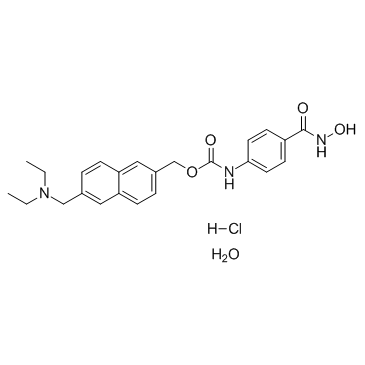732302-99-7
| Name | Givinostat |
|---|---|
| Synonyms |
{6-[(Diethylamino)methyl]-2-naphthyl}methyl [4-(hydroxycarbamoyl)phenyl]carbamate hydrochloride hydrate
Carbamic acid, N-[4-[(hydroxyamino)carbonyl]phenyl]-, [6-[(diethylamino)methyl]-2-naphthalenyl]methyl ester, hydrochloride, hydrate (1:1:1) Givinostat (hydrochloride monohydrate) |
| Description | Givinostat hydrochloride monohydrate is a HDAC inhibitor with an IC50 of 198 and 157 nM for HDAC1 and HDAC3, respectively. |
|---|---|
| Related Catalog | |
| Target |
hHDAC3:157 nM (IC50) hHDAC1:198 nM (IC50) hHDAC11:292 nM (IC50) hHDAC6:315 nM (IC50) hHDAC2:325 nM (IC50) hHDAC10:340 nM (IC50) hHDAC7:524 nM (IC50) hHDAC5:532 nM (IC50) hHDAC9:541 nM (IC50) hHDAC8:854 nM (IC50) hHDAC4:1059 nM (IC50) HD1-B:7.5 nM (IC50) HD1-A:16 nM (IC50) HD2:10 nM (IC50) |
| In Vitro | Givinostat (ITF2357) suppresses total LPS-induced IL-1β production robustly compared with the reduction by ITF3056. At 25, 50, and 100 nM, Givinostat reduced IL-1β secretion more than 70%. Givinostat suppresses the production of IL-6 in PBMCs stimulated with TLR agonists as well as the combination of IL-12 plus IL-18. IL-6 secretion decreases to 50% at 50 nM Givinostat, but at 100 and 200 nM, there is no reduction[1]. As shown by the CCK-8 assay, Givinostat inhibits JS-1 cell proliferation in a concentration-dependent manner. Treatment with Givinostat ≥500 nM is associated with significant inhibition of JS-1 cell proliferation (P<0.01). Also, the cell inhibition rate significantly differs between the group cotreated with Givinostat ≥250 nM plus LPS and the group without LPS treatment (same Givinostat concentration) (P<0.05)[2]. |
| In Vivo | Givinostat (ITF2357) at 10 mg/kg is used as a positive control and, as expected, reduced serum TNFα by 60%. Strikingly, pretreatment of ITF3056 starting at 0.1 mg/kg significantly reduces the circulating TNFα by nearly 90%. To achieve a significant increase in serum IL-1β production, a higher dose of LPS is injected (10 mg/kg), and blood is collected after 4 h. Similarly, when pretreated with lower doses of ITF3056 (1 or 5 mg/kg), there is a 22% reduction for 1 mg/kg and 40% for 5 mg/kg[1]. |
| Kinase Assay | Recombinant human HDAC enzymes (HDAC1- HDAC11) are used. Activity of HDAC1, HDAC2, HDAC3, HDAC6, HDAC10 and HDAC11 is assayed using the Fluor de Lys deacetylase substrate. HDAC8 activity is assayed using Fluor de Lys Green deacetylase substrate. N-Trifluoroacetyl-L-lysine is used to assay activity of HDAC4, HDAC5, HDAC7 and HDAC9. Recombinant enzymes are preincubated with Givinostat (ITF2357) or ITF3056 at 30°C in a volume of 25 μL in wells of a microtiter plate. After a brief incubation, 25 μL of substrate is added, and the fluorescent signal is generated by the addition of 50 μL of developer containing 2 μM Trichostatin A. For each assay, the amount of enzyme, incubation times, assay buffer, and concentration of the substrates are optimized. Positive control for enzyme activity consisted of enzyme plus substrate without Givinostat or ITF3056. The fluorescence signal is detected using a Victor multilabel plate reader[1]. |
| Cell Assay | After the JS-1 cell line is cultured in DMEM with 10% fetal bovine serum for 24 h, 30 wells of JS-1 cells are divided into two groups. In the first group, the culture medium is replaced by complete medium with final Givinostat concentrations of 0 nM, 125 nM, 250 nM, 500 nM, and 1000 nM. In the second group, Givinostat of relevant concentrations is added concomitantly with 100 nM of LPS solution. Three replicates are performed for each group. After inoculation at 37°C and 5% CO2 for 24 h, each well (100 μL) is incubated with 10 μL of CCK-8 solution. The plates are incubated at 37 °C for 1 h and the absorbance is measured at 450 nm using a microplate reader[2]. |
| Animal Admin | Mice[1] C57BL/6 mice are housed in the animal facility for at least 5 days before use. For the comparison study, Givinostat (ITF2357) at 10 mg/kg is administered orally, and ITF3056 is injected intraperitoneally. One hour after administration of the compounds, the animals are treated intraperitoneally with LPS from Salmonella typhimurium at a dose of 2.5 mg/kg. 90 min after the LPS treatment, mice are sacrificed, and sera are collected and stored at -80°C until further analysis of cytokine productions. |
| References |
| Molecular Formula | C24H30ClN3O5 |
|---|---|
| Molecular Weight | 475.965 |
| Exact Mass | 475.187408 |
| PSA | 100.13000 |
| LogP | 5.75090 |
| Storage condition | -20℃ |
